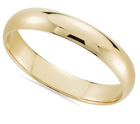 This article will tell you about the Japanese wedding ceremony in detail. It is a beautiful and meaningful event. Today, not many Japanese couples have this traditional ceremony, with all the ancient rituals, folk garments, and symbolism. And it’s a pity. You definitely must see the authentic Japanese wedding ceremony because, who knows, it might disappear in several decades.
This article will tell you about the Japanese wedding ceremony in detail. It is a beautiful and meaningful event. Today, not many Japanese couples have this traditional ceremony, with all the ancient rituals, folk garments, and symbolism. And it’s a pity. You definitely must see the authentic Japanese wedding ceremony because, who knows, it might disappear in several decades.
Our Japanese wedding ceremony was held at Hikawa Shrine in Akasaka last December. It was a cold, drizzly day, which may not be ideal for a wedding, but Japanese shrines look amazing with a little bit of rain. Plus it cleared up just in time for the ceremony so everything was perfect.
Although located near busy stations like Roppongi and Akasaka, Hikawa shrine is tucked away deep in its spacious garden and is very peaceful and private. The shrine is also dedicated to the Shinto god Susanoo and his wife Kushinadahime, and is, therefore, associated with good relationships and happy marriages. The 400-year-old gingko tree, that greets you at the entrance, was all lit up with its bright yellow foliage for our big day.
Now, let’s go inside and get ready.
Wedding outfit of Japanese groom
We’ll let my husband change first. The groom wears what’s called a "montsuki haori hakama".
"Mon" means emblem and refers to the family crest, which is printed on the "haori" - or kimono jacket. You’ll find one emblem on the back, right below the neck, two on the sleeves, and two on the chest.
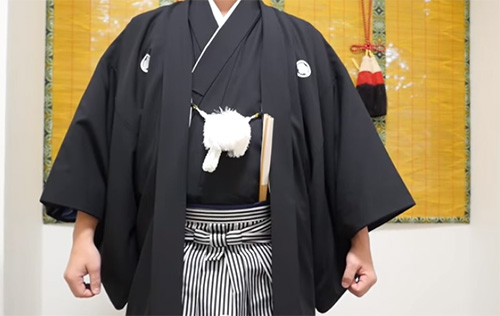
"Hakama" refers to the pants. The unique thing about kimonos is that it wears you. In other words, there’s no squeezing into anything, just lots of folding and tying. Lots of folding and tying.
The white pompom-looking thing in the front is the "haori himo", which loosely ties the font of the jacket together.
Wedding dress of Japanese bride
After Hagie did my makeup, it was time to put on that wig! Unlike most wigs, that are usually floppy and soft, this one was rock solid. It literally felt like wearing a helmet. But believe it or not, it’s actually not that uncomfortable. And thank goodness for that because the wedding kimono is.
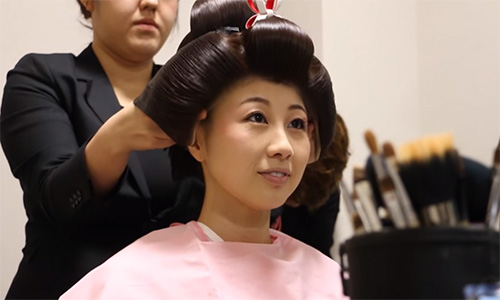
I wore a white wedding kimono called the "shiromuku". And wow, you wouldn't believe how much there is to it!
First, there’s the padding to create the basic shape. Then there’s the wrapping.
After you've got the basic shape, you put on the first layer called the "nagajyuban" (or nagajiban) and tie it into place.
Next, we have the second layer called the "kakeshita". That’s a lot of cords. And you definitely feel it.
The "obi" or large kimono belt is wrapped around the second layer. And how they tie this thing, I have no idea, but it looks pretty amazing!
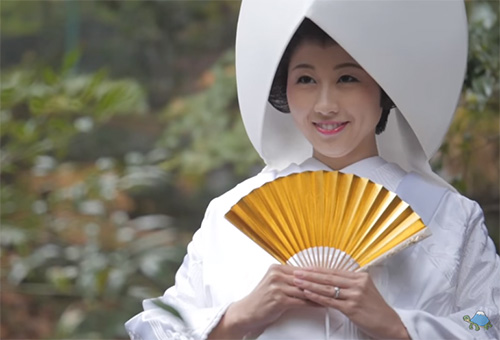
The last layer is the "uchikake," which is like a thick coat for kimonos. And it is thick! The "uchikake" have beautiful embroideries of plants, animals, and treasures that are thought to be good luck, such as cranes, orchids, and carriages.
After applying some color to my lips, we were ready for the final step – putting on the "wataboshi," which literally means cotton hat. An interesting fact: before becoming a headdress for weddings, the "wataboshi" was actually just a winter hat to keep warm. With a custom to cover the bride’s face for only the groom to see until after ceremony, the "wataboshi" with its large shape became a part of the wedding kimono.
This kimono is not the most comfortable thing. It's very very heavy. And my shoulder is starting to ache a little bit. But it's definitely worth it!
The white wedding kimono is generally assumed to symbolize purity and willingness of the bride to be "dyed in the grooms colors." But another theory suggests differently.
Wedding ceremony
We just got done rehearsing our parts for the wedding. And we our about to go outside and walk through the entrance and do the real thing. There's lot of little things we have to remember, so I'm a little bit nervous if I can do it correctly.
My dad and my grandma are here. My mom couldn't make it. She's in the states. But I'll be sending her pictures and she'll see this video, so it'll be all good.
The Japanese wedding ceremony is called the "shinzen kekkonshiki" and literally means “wedding before god”.
The ceremony begins with the performance of ancient court music for the "sanshin no gi", where the bride and groom are escorted to the pavilion by the shrine masters and maidens.
Three cups of sake
Inside the Pavilion, the Shinto priest announces our marriage to the Shinto gods and begins the "sankon no gi" – a ritual to strengthen the couple’s bond, where the bride and the groom take turns sipping sake from three sake cups increasing in size and poured three times. Although there are varying theories, many say that the first sake cup or “sakazuki” symbolizes the habits, showing appreciation for our ancestors.
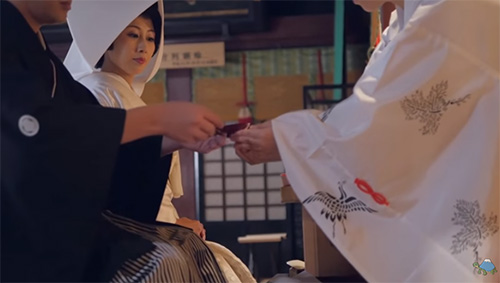
Oh, and make sure you wait till you’ve got something in your cup. That was embarrassing… Alrigh, let's try this again.
The second sakazuki symbolizes the earth, and the couple’s vow to care for each other as long as they live.
And the third represents people, and prays for the couple's fertility.
Ritual with the comb
The next ritual is one unique to the Hikawa shrine and involved the offering of a comb to the Shinto gods. The bride holds the comb, wrapped in cloth, in front of her heart and makes a prayer. She then gives the comb to the groom, who, by accepting it, shows the bride and the attendees, his determination and willingness to make the marriage work.
Wedding vows
Next, comes the reading of the vow. Reading the vow not to each other but to the Shinto gods. The script is prepared by the shrine and read by the groom as the couple stand together.
Offering a tree branch to gods
Next, we have the "tamagushi hoten," which is a special ceremonial offering of a sprig from a flowering evergreen tree to the Shinto gods. "Tamagushi" or the "spirit stick" carries our thoughts and prayers through the end of the branch to the gods.
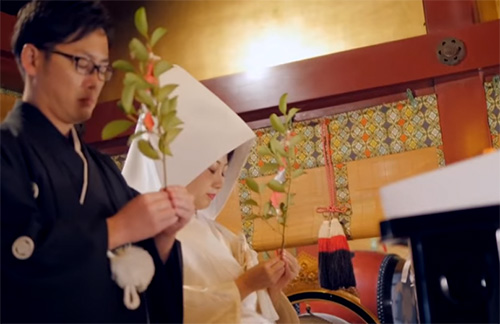
Exchanging of wedding rings
Lastly, we’ve got something simple and that most of your are familiar with. The exchanging of wedding bands. This ritual was not part of the original ceremony, but was added in the 1950s due to influence from Western-style weddings.
Ending of the ceremony
The ceremony ends with the "shinzoku katame no sakazuki", where the attendees drink sake and celebrate the two families coming together. And that concludes the "shinzenshiki".
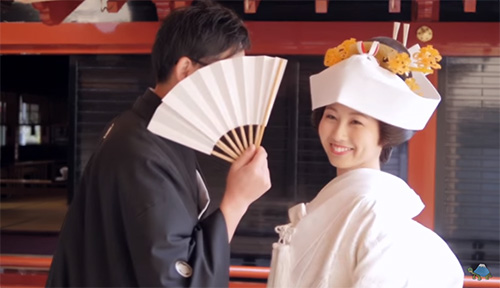
In the last few years, the "shinzenshiki" has regained popularity, with the increasing appreciation for kimonos and the "wa" spirit among younger generations. But still, western style weddings are much more common. To be honest, I, myself, never thought I would have a Japanese wedding.
(c)
